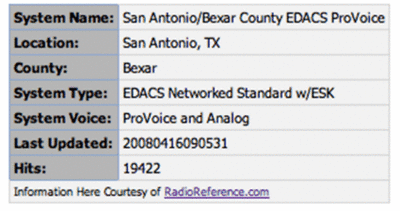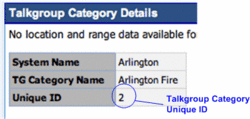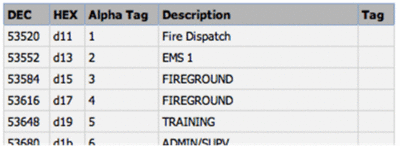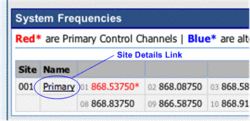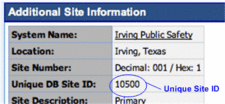Difference between revisions of "API"
From The RadioReference Wiki
| Line 1: | Line 1: | ||
The RadioReference.com Application Programming Interface provides a set of services for Webmasters and Application Developers to integrate data from radioreference.com into their own products. There are two core components of the RadioReference.com API: | The RadioReference.com Application Programming Interface provides a set of services for Webmasters and Application Developers to integrate data from radioreference.com into their own products. There are two core components of the RadioReference.com API: | ||
| − | + | * Javascript Remote Render Service | |
| + | * REST Based XML Web service | ||
| + | |||
| + | = The RadioReference Javascript Remote Render Display Service = | ||
The RadioReference Javascript remote render service allows webmaster and web page developers to integrate data from the radioreference.com database into their own Web pages. | The RadioReference Javascript remote render service allows webmaster and web page developers to integrate data from the radioreference.com database into their own Web pages. | ||
| − | + | == Steps for using the Javascript remote render service == | |
1. Apply for a domainKey at the following page on your account settings page: | 1. Apply for a domainKey at the following page on your account settings page: | ||
| Line 15: | Line 18: | ||
3. Add the necessary javascript code snippet and domainKey to your page for the data you want to remotely render. | 3. Add the necessary javascript code snippet and domainKey to your page for the data you want to remotely render. | ||
| − | + | == Data available for remote rendering == | |
| − | + | === Frequency Subcategory === | |
You can display a frequency subcategory on a Web page by adding the following code to the page: | You can display a frequency subcategory on a Web page by adding the following code to the page: | ||
| Line 45: | Line 48: | ||
[[Image:Scid_api_result.gif|border|400px]] | [[Image:Scid_api_result.gif|border|400px]] | ||
| − | + | === Trunked Radio System Information === | |
You can display a trunking system's general information on a Web page by adding the following code to the page: | You can display a trunking system's general information on a Web page by adding the following code to the page: | ||
| Line 72: | Line 75: | ||
[[Image:Sid_api_result.gif|border|400px]] | [[Image:Sid_api_result.gif|border|400px]] | ||
| − | + | === Talkgroup Category === | |
You can display a talkgroup category's talkgroups on a Web page by adding the following code to the page: | You can display a talkgroup category's talkgroups on a Web page by adding the following code to the page: | ||
| Line 100: | Line 103: | ||
[[Image:TgCid_api_result.gif|border|400px]] | [[Image:TgCid_api_result.gif|border|400px]] | ||
| − | + | === Trunked System Complete Talkgroup List === | |
You can display all talkgroups for a trunking system on a Web page by adding the following code to the page: | You can display all talkgroups for a trunking system on a Web page by adding the following code to the page: | ||
| Line 127: | Line 130: | ||
[[Image:Sidalltg_api_result.gif|border|400px]] | [[Image:Sidalltg_api_result.gif|border|400px]] | ||
| − | + | === Trunked System Site with Frequencies=== | |
You can display a individual trunked system site with frequencies on a Web page by adding the following code to the page: | You can display a individual trunked system site with frequencies on a Web page by adding the following code to the page: | ||
| Line 157: | Line 160: | ||
| − | + | = The RadioReference REST based XML Web service = | |
The radioreference.com REST based XML Web service is currently documented here: [[RadioReference.com_Web_Service]]. | The radioreference.com REST based XML Web service is currently documented here: [[RadioReference.com_Web_Service]]. | ||
Revision as of 12:58, 7 May 2008
The RadioReference.com Application Programming Interface provides a set of services for Webmasters and Application Developers to integrate data from radioreference.com into their own products. There are two core components of the RadioReference.com API:
- Javascript Remote Render Service
- REST Based XML Web service
Contents
The RadioReference Javascript Remote Render Display Service
The RadioReference Javascript remote render service allows webmaster and web page developers to integrate data from the radioreference.com database into their own Web pages.
Steps for using the Javascript remote render service
1. Apply for a domainKey at the following page on your account settings page:
2. Wait for your domainKey to be approved by the administration staff. You will receive an email to your email address on record when approved.
3. Add the necessary javascript code snippet and domainKey to your page for the data you want to remotely render.
Data available for remote rendering
Frequency Subcategory
You can display a frequency subcategory on a Web page by adding the following code to the page:
<script language="JavaScript" src="http://api.radioreference.com/js/?key=DOMAIN_KEY&scid=SUBCAT_ID"> </script>
- DOMAIN_KEY = Your uniquely assigned and active domain key
- SUBCAT_ID = The unique radioreference.com subcategory ID. This can be found by clicking the subcategory additional details icon for a subcategory.
For example, to display the Comal County Fire SO frequency subcategory on a page, you would add the following code:
<script language="JavaScript" src="http://api.radioreference.com/js/?key=12345678&scid=195"> </script>
The following would be displayed on the Web page where the code was inserted:
Trunked Radio System Information
You can display a trunking system's general information on a Web page by adding the following code to the page:
<script language="JavaScript" src="http://api.radioreference.com/js/?key=DOMAIN_KEY&sid=SID"> </script>
- DOMAIN_KEY = Your uniquely assigned and active domain key
- SID = The unique radioreference.com trunked system system identifier. This can be found by viewing the URL for the trunked system.
For example, to display the Bexar County / San Antonio EDACS system's general information, you would include the following code on your page:
<script language="JavaScript" src="http://api.radioreference.com/js/?key=12345678&sid=1434"> </script>
The following would be displayed on the Web page where the code was inserted:
Talkgroup Category
You can display a talkgroup category's talkgroups on a Web page by adding the following code to the page:
<script language="JavaScript" src="http://api.radioreference.com/js/?key=DOMAIN_KEY&tgCid=TGCAT_ID"> </script>
- DOMAIN_KEY = Your uniquely assigned and active domain key
- TGCAT_ID = The unique radioreference.com talkgroup category ID. This can be found by clicking the talkgroup category additional details icon.
For example, to display the City of Arlington's Fire Department Talkgroups from the Arlington Trunked System, you would add the following code:
<script language="JavaScript" src="http://api.radioreference.com/js/?key=12345678&tgCid=2"> </script>
The following would be displayed on the Web page where the code was inserted:
Trunked System Complete Talkgroup List
You can display all talkgroups for a trunking system on a Web page by adding the following code to the page:
<script language="JavaScript" src="http://api.radioreference.com/js/?key=DOMAIN_KEY&sidalltg=SID"> </script>
- DOMAIN_KEY = Your uniquely assigned and active domain key
- SID = The unique radioreference.com trunked system system identifier. This can be found by viewing the URL for the trunked system.
For example, to display all talkgroups for the Parker County TX Trunking system , you would add the following code:
<script language="JavaScript" src="http://api.radioreference.com/js/?key=12345678&sidalltg=5636"> </script>
The following would be displayed on the Web page where the code was inserted:
Trunked System Site with Frequencies
You can display a individual trunked system site with frequencies on a Web page by adding the following code to the page:
<script language="JavaScript" src="http://api.radioreference.com/js/?key= DOMAIN_KEY&siteId=SITE_ID"> </script>
- DOMAIN_KEY = Your uniquely assigned and active domain key
- SITE_ID = The unique radioreference.com siteId. This can be found by clicking the site description link for a trunked system site.
For example, to display the trunked system site for the Irving TX Public Safety Trunking System, the following code would be used:
<script language="JavaScript" src="http://api.radioreference.com/js/?key=12345678&siteId=10500"> </script>
The following would be displayed on the Web page where the code was inserted:
The RadioReference REST based XML Web service
The radioreference.com REST based XML Web service is currently documented here: RadioReference.com_Web_Service.




